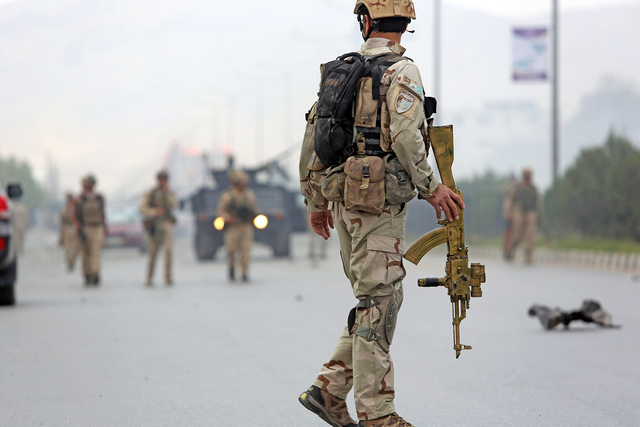KANDAHAR, Afghanistan — Afghan forces are struggling to man the front lines against a resurgent Taliban, in part because of untold numbers of “ghost” troops who are paid salaries but only exist on paper. ADVERTISING KANDAHAR, Afghanistan — Afghan forces
KANDAHAR, Afghanistan — Afghan forces are struggling to man the front lines against a resurgent Taliban, in part because of untold numbers of “ghost” troops who are paid salaries but only exist on paper.
The nationwide problem has been particularly severe in the southern Helmand province, where the Taliban have seized vast tracts of territory in the 12 months since the U.S. and NATO formally ended their combat mission and switched to training and support.
“At checkpoints where 20 soldiers should be present, there are only eight or 10,” said Karim Atal, head of Helmand’s provincial council. “It’s because some people are getting paid a salary but not doing the job because they are related to someone important, like a local warlord.”
In some cases, the “ghost” designation is more literal — dead soldiers and police remain on the books, with senior police or army officials pocketing their salaries without replacing them, Atal said.
He estimates that some 40 percent of registered forces don’t exist, and says the lack of manpower has helped the Taliban seize 65 percent of the province — Afghanistan’s largest — and threaten the provincial capital, Lashkar Gah. Those men who do serve face even greater danger because of the no-shows. In the last three months alone, some 700 police have been killed and 500 wounded, he said.
The province’s former deputy police chief, Pacha Gul Bakhtiar, said Helmand has 31,000 police on the registers, “but in reality it is nowhere near that.”
Nearly 15 years after the U.S.-led invasion that toppled the Taliban, and despite billions of dollars in military and other aid, corruption remains rife in Afghanistan and local security forces have struggled to hold off insurgent advances across the country. Last year the Taliban seized the northern city of Kunduz for three days, marking their biggest foray into a major urban area since 2001.
Pakistan will host four-nation talks Monday with Afghanistan, China and the United States aimed at reviving peace talks with the Taliban, but even if those efforts succeed the insurgents are expected to stay on the offensive in order to gain land and leverage.
The Defense Ministry declined to comment on ghost security forces. Interior Ministry spokesman Sediq Sediqqi acknowledged the problem and said an investigation has been launched, without providing further details.
Iraq has also struggled with the ghost soldier phenomenon, a factor in the Islamic State group’s rapid conquest of much of the country’s north and west in the summer of 2014. In December of that year, Iraqi officials said the payment of tens of millions of dollars in salaries to nonexistent forces had been halted.
But Afghan lawmaker Ghulam Hussain Nasiri, who has been researching the problem for more than a year, said his government is ignoring it.
“When we say we have 100 soldiers on the battlefield, in reality it is just 30 or 40. And this creates the potential for huge catastrophes when the enemy attacks,” he said.
“It is an indication of massive corruption — the reason Afghanistan is one of the most corrupt nations in the world,” he added. Afghanistan consistently ranks among the most corrupt countries in indices released by global watchdog Transparency International.
Nasiri said the government “doesn’t seem to want to know about it,” and that he received death threats after revealing the names of parliamentarians who are allegedly in on the racket. He said he handed a list of 31 names of corrupt parliamentarians to the Interior Ministry but has so far received no response.
Cash-strapped Afghanistan’s security forces are entirely funded by the international community, at a cost of some $5 billion a year, most of which comes from the United States. The U.S. government’s auditor of spending in Afghanistan, John Sopko, told a congressional hearing last year that Afghan government figures on security personnel and pay could not be regarded as accurate.
“No one knows the exact numbers of the Afghan National Defense Forces,” an Afghan official said on condition of anonymity because he was not authorized to brief media on the topic. He said the best internal estimates put the number at around 120,000, less than a third of what’s needed to secure the country.
The heaviest cost of the ghost soldier phenomenon is being exacted on the battlefield. Neither the government nor NATO publicizes casualty figures for local security forces, but an internal NATO tally seen by The Associated Press shows casualties are up 28 percent from 2014, when some 5,000 Afghan forces were killed.
Last month, an army base in Helmand’s Sangin district was besieged by insurgents for almost a week before reinforcements were rushed in backed by U.S. airstrikes and British military advisers.
In the northern Helmand district of Kajaki, soldier Mohammad Islam said many of his comrades deserted their posts because they didn’t believe their bodies would be sent back to their families if they died. In the absence of a body, the family would not be eligible for compensation payments.
“Everyone knows that we are facing this fight alongside ‘ghost’ soldiers, and that’s the reason we don’t have enough men,” he said. “The Taliban know it, too. When they attack us, and we’re unable to protect ourselves, the big men then ask why.”



